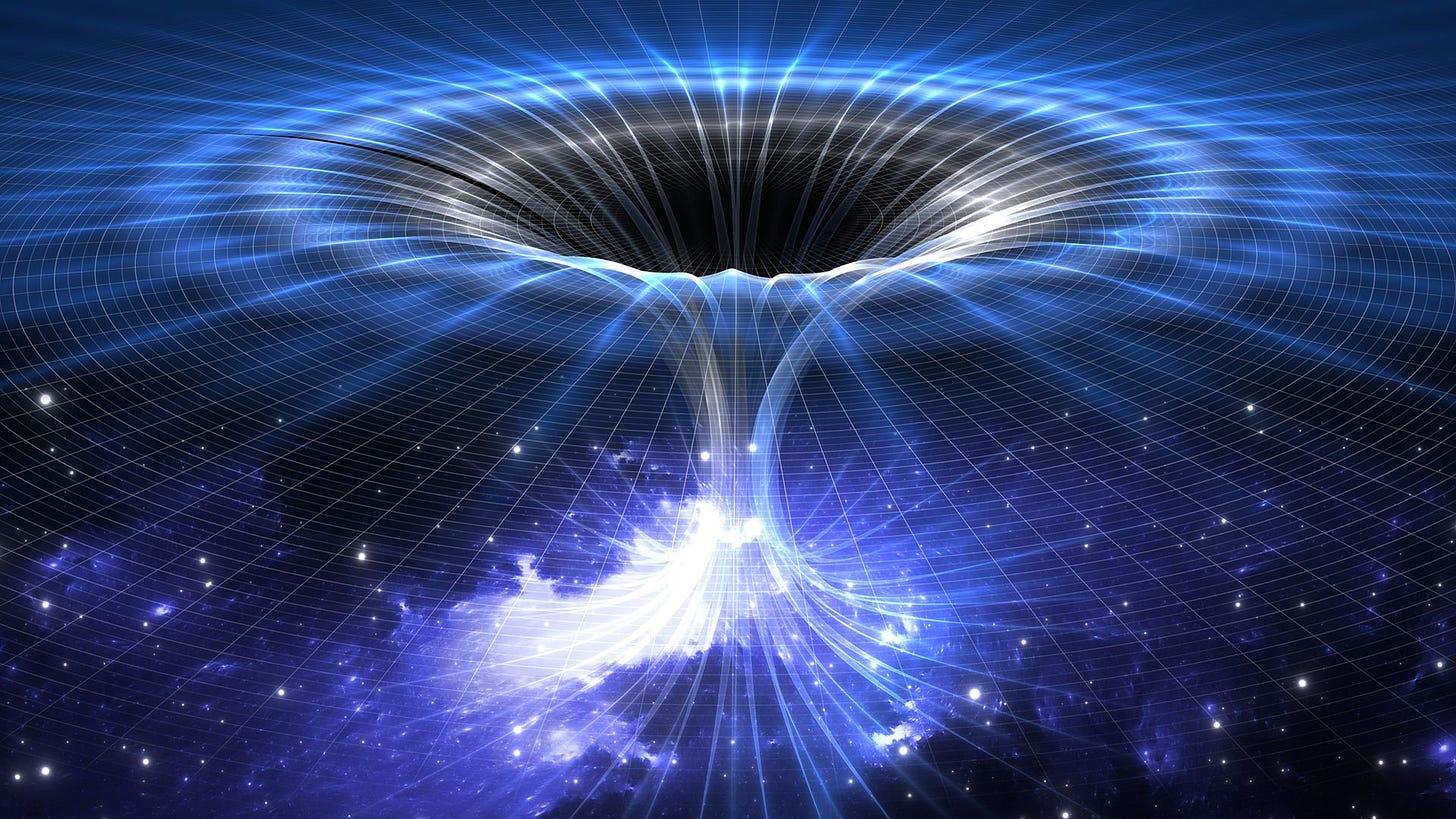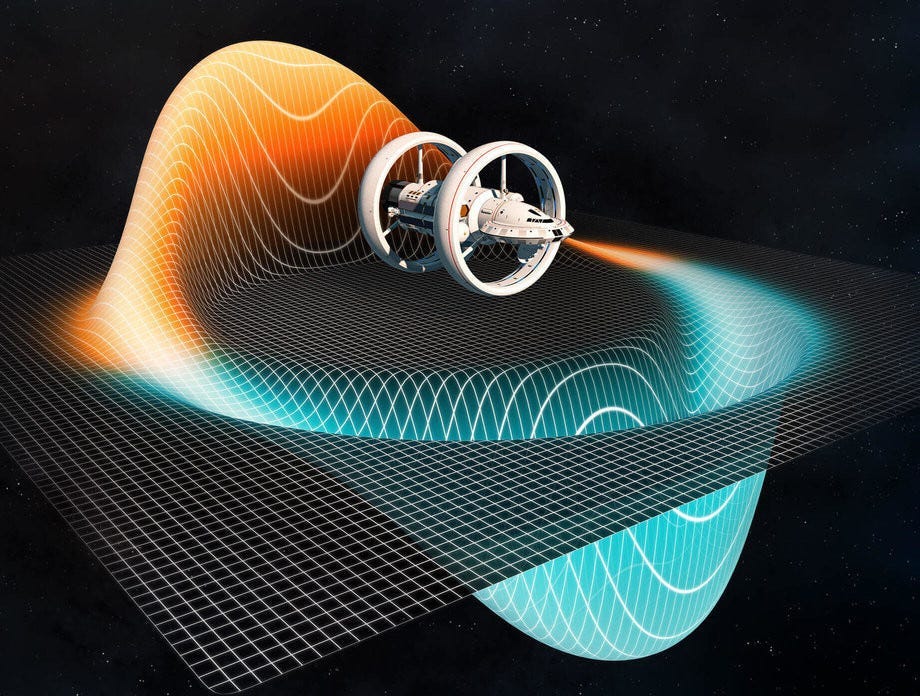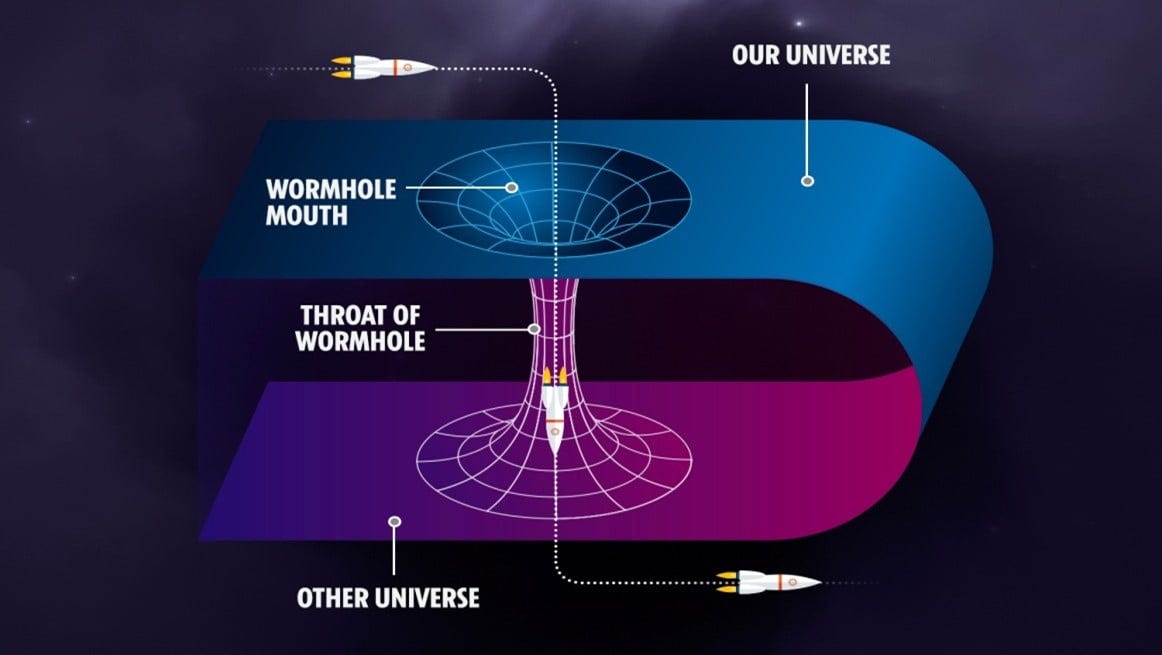Musings on the Impossible, Part 5
Faster than the speed of light?
It’s a major theme in hard SF and Space Operas: can the speed of light in a vacuum be exceeded? Many Space Operas basically mention a faster-than-light drive by way of handwavium in order to get to their main raison d’être; that is, the adventures in other star systems or the machinations of interstellar empires and/or civilisations. In most hard SF, however, authors try to provide a more logical rationalisation for breaking the speed of light.
Before I get to the major candidates, a major spoiler (or buzzkill). Moving faster than the speed of light enables causal violation1—effects preceding causes—and the chronology protection conjecture (a hypothesis proposed by Stephen Hawking) prevents this.
TL;DR1: if Stephen Hawking is right, then faster-than-light travel is not possible;
Personally, though, I think that if faster-than-light travel is used between star systems—that is, systems several lightyears apart—then causal violations are still prevented. Also, there is the idea that a time traveller is taken to a parallel Universe while their original timeline remains intact.
TL;DR2: if David Deutsch is right2, then faster-than-light travel is still possible;
Having gotten that out of the way, here are the possible ways in which the speed of light in a vacuum can be either increased or bypassed3 (also note that there are a few interesting interlinks between the methods, which I will highlight):
Inside Casimir Plates;
Tachyons;
Quantum Tunnelling;
Quantum Entanglement;
Alcubierre Drive;
Wormholes;
Inside Casimir Plates:

Even in the vacuum of space photons—particles travelling with the speed of light in a vacuum—experience resistance. Which resistance?, you ask. The vacuum of space is not empty, but filled with virtual particles that pop into existence by dint of Heisenberg’s Uncertainty Principle, a process called ‘vacuum fluctuations’. The Dutch physicist Hendrik Casimir proposed—together with Dirk Polder—the Casimir Effect which predicts that two uncharged plates that are kept a few nanometres apart will experience a force that tries to push them together.
Due to their close approximation, the vacuum between the two plates only allows a certain type of virtual particles to pop into existence, meaning the vacuum between the plates has fewer virtual particles than the vacuum outside these plates.
Casimir proposed it in 1948. Subsequently, experiments have measured the force within 5% of the value predicted by the theory. Therefore, light does indeed go faster between Casimir plates. It has been dubbed ‘the light velocity Casimir Effect’ or ‘the Scharnhorst Effect’.
However, before anybody becomes excited, the effect is truly minuscule; that is, if the plates are placed 1 micrometre apart, the increase of light speed is only about one part in 1036 . This is so small that current technology cannot even measure it. So:
Advantage: It’s true!
Disadvantage: a nano-starship travelling at light speed between Casimir plates kept one micrometre apart stretching all the way from Sol to Alpha Centauri will arrive 1.3 x 10-29 seconds before a similar one travelling the normal interstellar vacuum4.
Conclusion: impractical for interstellar travel. However, Casimir Plates—especially when travelling close to the speed of light—might have some other interesting properties that might be utilised (I’m speculating about this in my novel “The Transcendence of Consensual Reality”).
Tachyons:

Tachyons are hypothetical particles that cannot move faster than the speed of light; that is, the speed of light is their minimal speed (if they have infinite mass) while there is no limit to their maximum speed (if they have zero mass).
Tachyons have been used as faster-than-light communication in Frank Herbert’s Dune, Dan Simmons’s Hyperion, in Gregory Benford’s Timescape—probably the usage closest to possible by science as we know it—and in Robert J. Sawyer’s Flashforward, amongst others.
Unfortunately, no physical evidence for the existence of tachyons has been found, to date. However, since in modern physics all fundamental particles are regarded as excitations of quantum fields, tachyons could be viewed as excitations of a Lorentz invariant quantum field with imaginary mass. However, such an excitation is unstable and leads to tachyon condensation, and all known tachyon condensation events are cases of spontaneous symmetry breaking. Confused? So am I, but what I do understand is that neither of these break the speed of light, nor violate causality5.
However, according to this paper (and possibly others), tachyons can exist in a different Universe (or in a Multiverse). To paraphrase: ‘if a tachyon moves with v > c, then its mass becomes imaginary, and is in some other place. Owing to the condition v > c, this other place is beyond the event horizon (of this Universe, not a black hole6).’
While this is interesting—and I’m using these possibilities in my novella (a WiP) called “The Cryptomancers at the Heart of the Galaxy”—it means we need to go to another Universe to break the speed of light (because that other Universe has different physical laws, which begs the question if we could actually survive in there).
Advantage: Might exist.
Disadvantage: But, most probably, not in this Universe.
Conclusion: only possibly practical for interstellar travel if we could somehow jump to a faster-than-light Universe and from there jump back to here7. If we can survive in that alien Universe. A stupendously long shot, if possible at all.
Quantum Tunnelling:

This is a quantum mechanical phenomenon where an object passes through a barrier that—according to classical mechanics—it should not have sufficient energy to do so. It can because the object—an elementary particle such as an electron or a prton—has a wave/particle duality, and the wave nature of it enables it to perform a quantum tunneling (see also the GIF above).
Advantage: Is an actual process;
Disadvantage: Only seems to work for smaller distances (< 1 nanometre) and single elementary particles + only a small part of the wave packet passes through;
Conclusion: Unsuitable for interstellar travel;
Quantum Entanglement:
Quantum Entanglement has been proven in several experiments. However, it has several limits:
1. It cannot be used to transport persons or goods;
2. Theoretically, it might be used for transporting messages (however a method for that has not yet been found);
3. Once entangled, the separate particles (if communication via quantum entanglement is possible, then the more pairs, the higher the bandwidth) must be moved apart at a speed lower than the speed of light;
4. Quantum entanglement is very sensitive to decoherence;
The principle of instant communication has been popularised by Ursula K. LeGuin who called such an apparatus an ‘Ansible8’, and has subsequently been adopted by other F writers.
Advantage: While it does exist, it is unclear if its properties can be utilised for faster-than-light communication;
Disadvantages: May only transport messages + the sender and receiver have to be spaced apart at sublight speeds before the instant communication can be used.
Conclusion: It’s a bit like an old-fashioned telephone or a modern internet connection: first the infrastructure must be laid before it can be used. So not suitable for interstellar travel, but very suitable for interstellar communication, especially of an established interstellar civilisation;
Alcubierre Drive:
The Wikipedia article linked above explains this theoretical drive—proposed by theoretical physicist Miguel Alcubierre—at a much greater length, let me just say that the Alcubierre Drive warps spacetime before and after a starship, effectively ‘pushing spacetime aside’, which in its turn makes speeds higher than the speed of light possible.
If squinted at the right angle, Star Trek’s ‘Warp Speed’ might be interpreted as a practical Alcubierre Drive. Even if Miguel Alcubierre only proposed it in 1994—way before Star Trek’s first season in 1966/67—then this would be another claim of how Star Trek foresaw the future [via
].Advantages:
1) This is theoretically possible within the framework of Einstein’s general relativity9;
2) There would be no relativistic effects such as time dilution that take place at speeds close to lightspeed10;
Disadvantages:
1) The warp bubble around the spaceship has a negative energy density which either requires exotic matter or the manipulation of dark energy (however, Alcubierre argued that the Casimir vacuum between parallel plates could fulfill these requirements11);
2) Meaning that once the amount of either exotic matter or dark energy carried by the spaceship—basically its ‘fuel’—runs out, v < c and faster-than-light travel stops;
3) Thus spaceships with Alcubierre Drives may have an even bigger fuel/cargo ratio than modern airplanes;
4) And like modern airplanes, this means the longer the distance, the more fuel is needed which may limit the maximum possible distance travelled;
Conclusion: If possible, it will require a new type of starship plus a new and highly advanced infrastructure for producing and storing the ‘exotic matter’ or ‘dark energy’ fuel needed to power the starship, in combination with possible cargo and distance limitations, not unlike those found in modern air travel;
Wormholes:
A wormhole is a hypothetical structure connecting disparate points—A and B—in spacetime and is based on a special solution of Einstein’s field equations. As such, the length of the wormhole might be shorter than the distance between the two points, in which case crossing the wormhole at close-to-light speeds would effectively mean getting from point A to point B at higher than lightspeed.
Wormholes have the same disadvantage as quantum entanglement; that is, both sides need to be produced in one place, after which one side has to be transported to the place one wishes to have instant access with, at a speed below the speed of light.
Wormholes have to be kept open via the insertion of so-called exotic matter (I’m not sure if that’s the same type of exotic matter needed for an Alcubierre Drive, or a different type altogether12). Thus, once a civilisation has established a pair of wormholes, these need to be kept open with a constant flow of exotic matter.
This means the manufacture of a facility that produces exotic matter in sufficient amounts. And when one wormhole is transported to the remote place with which this civilisation wants to have instant access, another exotic matter production facility has to travel with the wormhole.
Advantage: Theoretically possible;
Disadvantage: As with quantum tunnelling and quantum entanglement, the two ‘stations’ need to be spaced apart at sub-light speeds + the constant flow of exotic matter needed to keep them open;
Conclusion: a kind of interstellar subway system through which the ‘trains’ would effectively move at v > c. However, first space must be crossed at sub-light speeds with one entrance of the wormhole tunnel first, meaning setting up such an infrastructure will be both costly and time-cnsuming. Therefore, good for exisiting interstellar societies (with plenty of resources), but not for space exploration;
These are the methods that I am aware of. If you know another (or even more than one), please do feel free to add these in the comments.
An addendum:
Suppose that breaking the light speed barrier is truly impossible in this Universe? Then science fiction needs to adapt its storytelling techniques. Too many space operas use some kind of handwavium to allow for faster-than-light travel, so that the future civilisations they describe do not differ too much from those we already know. In my very unhumble opinion, that’s a deriliction of duty as an SF writer.
In a Universe with a light speed limit and stars at light year distances, future societies will have a different structure than those of today. The colonial empires of the 16th and 17th centuries come to mind13 where the colonies were several months of travel—by sailing vessels—away from the homeland. Now make those distances many, many years, meaning a future civilisation—hopefully not an empire as these should become obsolete in the (far) future—will be more like an archipelago of different, isolated islands rather than a homogenous federation. Trade will work differently (Charles Stross’s “Neptune’s Brood”, for example, imagines a three-layered cryptocurrency system for that14) and qualitatively different goods and/or services will become valuable (linked with the previous ‘Immortality’ musing essay, I strongly suspect life extension treatments will become extremely valuable and might replace money—even in the form of cryptocurrency—as currency).
More complications will arise because the new star systems will be either be empty of life—meaning suitable planetary bodies within a star’s habitable zone15 will need to be terraformed, a process that will take many centuries or more—or will have already been occupied with aliens or alien life (which in its turn will give many complications—the stuff on which truly good SF thrives).
It means all these slower-than-light explorers are basically on their own.
And yes, there have been SF novels incorporating slower-than-lightspeed travel, (not to mention all the generation starship novels) such as Arthur C. Clarke’s Rendezvous with Rama, the above-mentioned Neptune’s Brood, Alastair Reynolds’s Revelation Space and sequels, several novels by Greg Egan, Linda Nagata, David Brin and more. Yet they are a distinct minority in comparison to all the FTL space operas out there.

Author’s Note: Aaargh! I just found out that the footnotes16 that seemed to survive a copy & paste from a Word document (they didn’t from a Pages document) do not actually link in Substack posts (they’re just copied below with no back-and-forward links). Corrected it for this post, but must now update a number of earlier posts (“perfection is my middle name,” as Primus bass player Les Claypool sings in “Mr. Knowitall”).
Welcome to the new subscribers, and thanks for reading!
translation: makes time travel possible;
A major proponent of the existence of the Multiverse;
Some of these are highly theoretical. But hey, this is for science fictional usage so we take all we can get…;-)
Reduce the distance to 10 Planck Lengths = 10-34 metres, then one gains 132,451 seconds per 4.2 lightyears. So shooting and capturing photons through such a Casimir Plate will produce photons that are 31,536 seconds time-shifted per lightyear per microgram. Store them in Time Capacitors. Then a 100-ton starship can be time-shifted 31,536/(100 x 1000 x 1,000,000) = 0.00000031536 per Casimir Plate or 0.31536 seconds per million Casimir Plates per lightyear!
Nevertheless, I use tachyonic fields as distration tactics as my protagonists take on god-like beings in my novella—still a WiP—“The Cryptomancers at the Heart of the Galaxy”;
Although I utilise tachyons as existing inside the supermassive black hole of our galaxy in the novella mentioned in the previous footnote;
Hyperspace, anyone?
NB: limitation of Google and other modern search engines: ‘ansible’ links to a suite of software tools, while no links to its original usage show up, not even to the Wikipedia article;
The best of both worlds: Einstein remains right while we can move with speeds higher than the speed of light in a vacuum;
Some may find that a disadvantage, especially if an Alcubierre Drive only exceeds the speed of light with a factor less than 2;
Interlink between Alcubierre Drive and Casimir plates;
Interlink between Alcubierre Drive and Wormholes;
Not that I condone those, mind you, as they were brutally repressive regimes;
Which gets you damned with a ‘smartest-guy-in-the-room’ faint praise in a Publisher’s Weekly review;
If these are there;
And footnotes are fun, don’t let anybody tell you different…;-)





